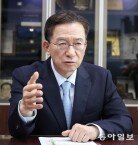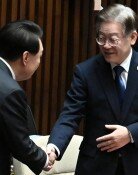More Government Employees Are for Whom?
More Government Employees Are for Whom?
Posted February. 24, 2005 22:33,
As the Roh Moo-hyun administration pursues a big government, the number of government employees late last year recorded an all-time high since 1997.
Under these circumstances, some are raising criticism that the quality of public services is at a standstill, although much more taxpayers money is being spent for public officials in labor costs.
Experts warn that there is an urgent need for a government restructuring so that it can pursue a small government and activate the function of the market.
The Ministry of Planning and Budget and the Ministry of Government Administration and Home Affairs noted on February 24 that there were, as of late 2004, 931,872 government officials working for the administration, the legislature and the judicature, the biggest number since the end of 1997, when Korea was in the midst of an economic crisis and had 935,759 government employees.
Provided that the government plans to hire 35,160 new employees this year, it is estimated that the number of government officials will reach a whopping 967,032.
The number of government employees had been on the decrease for four years in a row (1998 through 2001), due to the governments restructuring efforts since the financial crisis that hit hard Korea. However, it started to show about a two percent annual increase in 2002, and now is about to return to its 1997 level.
Government workers have grown in numbers by 4.7 percent since the Roh Moo-hyun administration was inaugurated back in February 2003, a figure that is 2.9 percentage points higher than the increase in the number of employees during the corresponding period, which is 1.8 percent.
There were 183 to 189 government employees per every 10,000 people under the Kim Dae-joong government. However, it grew to 194 under the incumbent administration and is projected to pass the 200 mark.
Economist Gong Byeong-ho explained, With the focus of the governments plans switching to distribution, the governments role as well as the number of government workers have grown at the same time, adding, It seems the government has decided to tread the path of big government, not small government, in which it accentuates the function of the market.
Nevertheless, the quality of public services felt by the public is not likely to improve greatly, as the number of government employees of fifth or higher grade shot up by 10.2 percent from 2000 through 2004, while the number of workers lower than sixth grade just increased by 6.9 percent. In other words, the number of high-ranking officials who present the direction of government plans grew a lot, while that of low-ranking officials, who are supposed to do work that deals with the public directly, displayed a relatively small increase.
With the increase in the number of government officials, more money is being spent for them in labor costs.
According to the Ministry of Planning and Budget, as of late 2004, about 19.3 trillion won was spent for central government officials in labor costs, up 7.0 percent from 18.64 trillion won of late 2003. In effect, every citizen is paying a tax of 410,000 won for central government officials in labor costs every year.
The governments regulations have increased likewise: there were about 14,000 governments regulations back in 1998, and that number fell to about 6,900 in 2000. Now, the number has grown for the past four years and stands somewhere around 7,900.
Chief researcher Cho Seong-bong from the Korea Economic Research Institute analyzed, It is the result of the governments strategy to have more regulatory fields and employees aimed at securing a larger proportion of the budget.
Chang-Won Kim legman@donga.com changkim@donga.com
Headline News
- Med professors announce intention to leave hospitals starting Thursday
- Bridge honoring Sgt. Moon Jae-sik unveiled in Pennsylvania
- Chief of Staff Chung tells presidential secretaries to stay away from politics
- US FTC bans noncompete agreements
- N. Korea launches cyberattacks on S. Korea's defense companies







